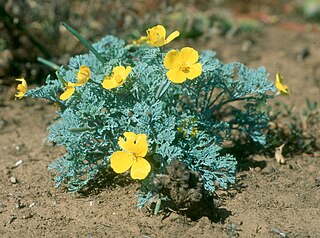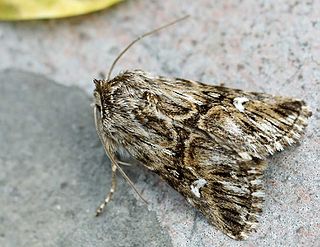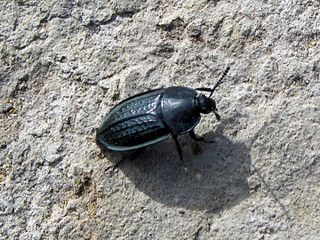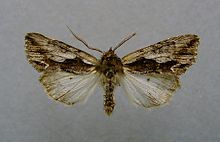Mohlakeng is a township west of Johannesburg in Gauteng, South Africa.

The mosaic moray is a moray eel of the genus Enchelycore, found in south-eastern Australia and around the offshore islands off Northland on the North Island of New Zealand at depths down to 100 metres, in reef areas of broken rock. Their length is between 40 and 180 centimetres, making them the largest known member of their genus.

The hybrid elm cultivar Ulmus 'Den Haag' is a Dutch development derived from a chance crossing of the Siberian Elm cultivar Ulmus pumila 'Pinnato-ramosa' and the Belgian Elm Ulmus × hollandica 'Belgica'. S. G. A. Doorenbos (1891-1980), Director of Public Parks in The Hague, finding that seeds he had sown in 1936 from the Zuiderpark 'Pinnato-ramosa' had hybridized with the local 'Belgica', selected six for trials. The best was cloned and grafted on 'Belgica' rootstock as 'Den Haag'; it was planted first in that city, then released to nurseries elsewhere in the Netherlands. The other five were also planted in The Hague.

The Siberian elm cultivar Ulmus pumila 'Pinnato-ramosa' was raised by Georg Dieck, as Ulmus pinnato-ramosa, at the National Arboretum, Zöschen, Germany, from seed collected for him circa 1890 in the Ili valley, Turkestan by the lawyer and amateur naturalist Vladislav E. Niedzwiecki while in exile there. Litvinov (1908) treated it as a variety of Siberian elm, U. pumilavar.arborea but this taxon was ultimately rejected by Green, who sank the tree as a cultivar: "in modern terms, it does not warrant recognition at this rank but is a variant of U. pumila maintained and known only in cultivation, and therefore best treated as a cultivar". Herbarium specimens confirm that trees in cultivation in the 20th century as U. pumilaL. var. arboreaLitv. were no different from 'Pinnato-ramosa'.

Asterogyne is a genus of flowering plant in the family Arecaceae native to Central America and northern South America, with three of the five known species endemic to Venezuela.

Eschscholzia ramosa is a species of poppy known by the common name Channel Islands poppy, or simply island poppy.

Cuculliinae is one of the larger subfamilies of moths in the family Noctuidae.

Calliergis is a genus of moths of the family Noctuidae. The genus was erected by Jacob Hübner in 1821.

Aechmea ramosa is a plant species in the genus Aechmea. This species is endemic to eastern Brazil.

Orobanche ramosa is a species of broomrape known by the common names hemp broomrape and branched broomrape. It is native to Eurasia and North Africa, but it is known in many other places as an introduced species and sometimes a noxious weed.

The Kallergis family is a Cretan Greek aristocratic family which claims descent from Byzantine Emperor Nikephoros II Phokas, and were at one stage the most powerful noble family of Crete.

Tragia ramosa is a species of flowering plant in the spurge family known by the common names branched noseburn, and desert tragia.

Oncocnemidinae is a subfamily of moths which belong to the large moth family (Noctuidae). In contrast to most other members of the family, they fly during the day. Oncocnemidinae are small, dark coloured moths, but the backs of their wings are generally white with broad, black stripes.
Rigifilida is a clade of non-ciliate phagotrophic eukaryotes. It consists of two genera: Micronuclearia and Rigifila.

The Ulmus pumila cultivar 'Aurescens' was introduced by Georg Dieck at the National Arboretum, Zöschen, Germany, circa 1885. Dieck grew the tree from seed collected in the Ili valley, Turkestan by the lawyer and amateur naturalist Vladislav E. Niedzwiecki while in exile there. Dieck originally named the tree U. pinnato-ramosaf.aurescens.

Goniastrea is a genus of stony corals in the family Merulinidae. Species belonging to the genus Goniastrea forms massive colonies, usually spherical or elongate, with well developed paliform lobes. Polyps can be seen only at night.
The elm cultivar Ulmus 'Turkestanica' was first described by Regel as U. turkestanica in Dieck, Hauptcat. Baumschul. Zöschen (1883) and in Gartenflora (1884). Regel himself stressed that "U. turkestanica was only a preliminary name given by me; I regard this as a form of U. suberosa" [:U. minor ]. Litvinov considered U. turkestanicaRegel a variety of his U. densa, adding that its fruits were "like those of U. foliaceaGilibert" [:U. minor].

Heterosilpha ramosa, the garden carrion beetle, is a species of carrion beetle in the family Silphidae. It is found in Central America and North America.

Polygala ramosa is a species of flowering plant in the milkwort family (Polygalaceae). It is endemic to the coastal areas of the Southern and Eastern United States. It is an annual herb with a height of 10 to 40 centimetres that produces yellow flowers between the months of May and September.
Lichtheimia ramosa is a saprotrophic zygomycete, typically found in soil or dead plant material. It is a thermotolerant fungus that has also been known to act as an opportunistic pathogen–infecting both humans and animals.
This page is based on this
Wikipedia article Text is available under the
CC BY-SA 4.0 license; additional terms may apply.
Images, videos and audio are available under their respective licenses.

















